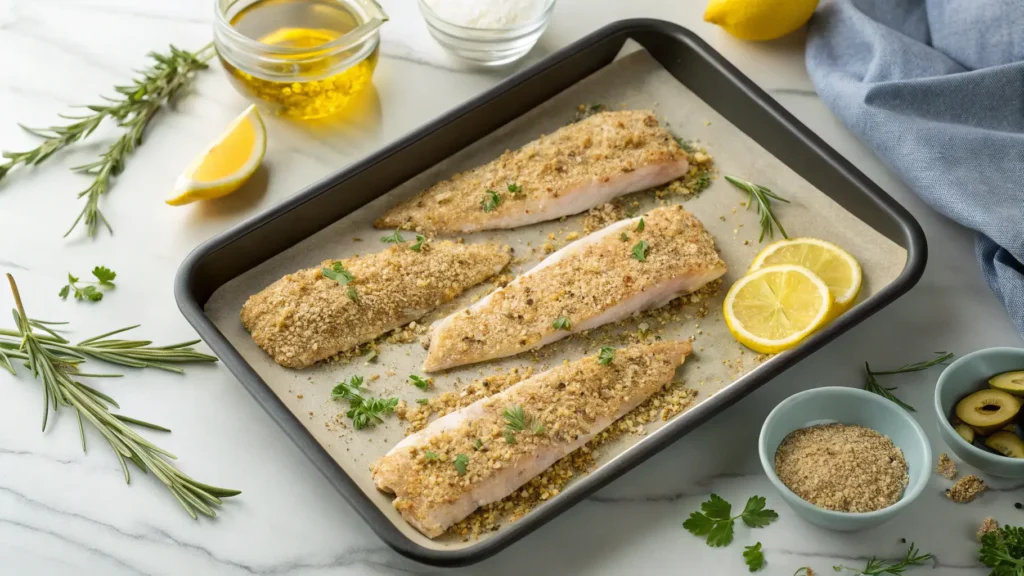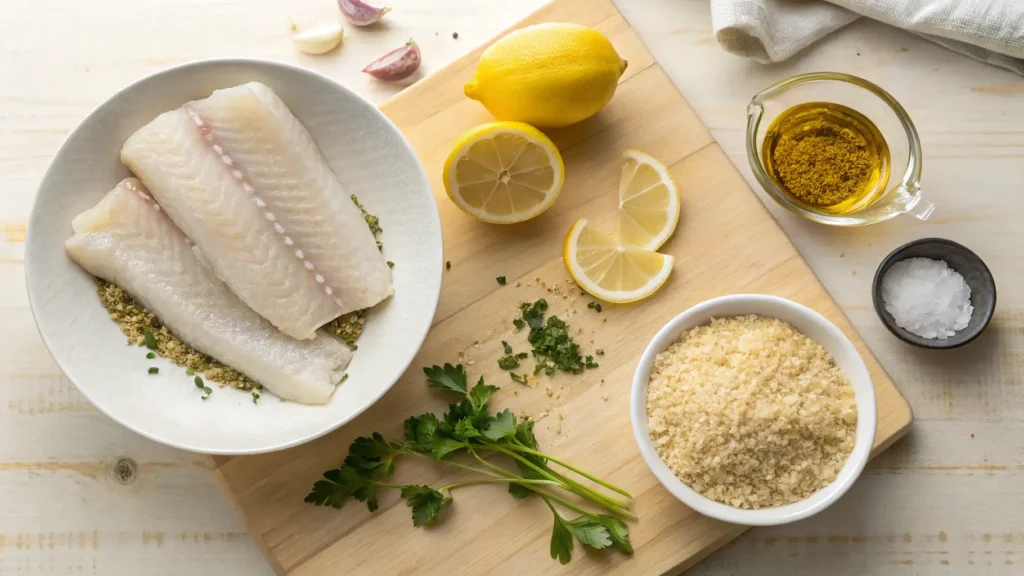Ever wanted something that’s both tasty and good for you? Imagine the smell of fresh fish and the crunch of a golden breadcrumb topping in your kitchen. Baked fish fillets are not just tasty but also healthy.
This easy recipe is great for busy weeknights. It lets you enjoy a delicious meal without feeling guilty. The toppings make the fish even more special.
Whether you’re new to cooking or experienced, making these baked fish fillets is fun. You only need a few ingredients like fish, herbs, and spices. For a detailed guide, check out this baked fish recipe.

Key Takeaways
- Baked fish fillets offer a healthy and delicious meal option.
- The crispy breadcrumb topping adds texture and flavor.
- This easy baked fish recipe is quick to prepare.
- Flaky fish paired with herbs enhances the dish’s richness.
- Perfect for both family dinners and entertaining guests.
Introduction to Baked Fish Fillets
Baked fish fillets are a great choice for a healthy and tasty meal. This method keeps the fish moist and enhances its natural flavors. You can find many fish fillet recipes to match your taste and dietary needs.
It’s easy to make a dish that everyone will love. You can use simple seasonings or add exciting flavors. Baking is easy and makes your meal both convenient and delicious.

Why Choose Baked Fish Fillets?
Baking fish is a tasty way to cook and it’s good for you too. It keeps the fish’s nutrients, so you get the most health benefits. Baked fish is full of omega-3s, which are great for your heart and help you stay healthy.
Health Benefits of Baking Fish
Baking fish makes your meals even healthier. It’s better than frying because it doesn’t add bad fats. The omega-3s in baked fish are good for your brain and overall health.
Lower Fat Content Compared to Frying
Choosing to bake instead of fry means less fat in your food. This method is better for your health because it uses less oil. It helps you make a tasty dish that fits well with a healthy lifestyle.

Ingredients for Baked Fish Fillets With Seasoned Breadcrumb Topping
Choosing the right ingredients is key for baked fish fillets with a crispy topping. The best fish adds a lot to the flavor and texture. Look for types of fish for baking that stay moist and tasty.
Essential Fish Types to Use
For baked recipes, mild white fish works best. It absorbs flavors well and stays flaky. Here are five great options:
- Haddock
- Cod
- Catfish
- Pollock
- Sole
Best Breadcrumb Options
The right breadcrumbs make the dish better. Panko breadcrumbs are great because they stay crunchy. They also don’t soak up too much oil, adding a nice crunch to the fish.
If you can’t find panko, try:
- Toasted breadcrumbs
- Cracker meal
Preparation Steps for the Perfect Baked Fish
Getting your fish ready is key for a tasty baked dish. Focus on picking the right fish and preparing it well. This ensures great taste and texture. Follow these steps for a successful cooking journey.
Choosing the Right Fish Fillets
Look for fish fillets that are firm and smell mild. Freshness matters, so check the color and feel. If they look vibrant and moist, they’re good.
Frozen fish is also a good choice. Just thaw them in the fridge overnight or in cold water in a bag.
Preparing the Baking Sheet
Preparing your baking sheet is important too. Use parchment paper or aluminum foil to line it. This makes cleaning up easier and helps the fish come off without sticking.
Don’t forget to spray the sheet with non-stick spray. This prevents sticking and makes the fish easy to remove. Your baked fish fillets will turn out perfectly.
How to Season Your Fish Fillets
Seasoning your fish fillets is key to making a simple dish great. The right seasoning brings out the fish’s natural taste and adds depth. Using different herbs and spices makes your dish exciting.
Using Herbs and Spices for Flavor
Fresh herbs like parsley, cilantro, and dill add a burst of freshness. They enhance the fish’s flavor and texture. Spices like cumin, paprika, or Cajun seasoning add a rich taste.
Try drizzling olive oil and lemon juice on your fillets. It boosts the flavor and balances with spices and herbs. Mixing herbs and spices lets you make each dish special.
Baking Techniques for Crispy Breadcrumb Topping
To get a crunchy topping on your baked fish, use the right techniques. Panko breadcrumbs and the right coating method make a tasty crust. These steps will turn simple fish into a fancy dish.
Importance of Panko Breadcrumbs
Panko breadcrumbs are key for a crispy fish topping. Their coarse texture gets crispy when baked. Unlike regular breadcrumbs, panko doesn’t soak up much oil. This keeps the fish moist and adds a nice crunch.
Steps to Achieve Crispy Fish
To bake crispy fish, follow these easy steps:
- Season your fish fillets with salt and pepper.
- Coat each fillet in flour for a base layer.
- Dip the fillets in a whisked egg mixture to cover them fully.
- Then, coat the fish with panko for a thick crust.
- Put the fillets on a preheated baking sheet at 425°F. Let the crust get crispy.
By following these steps, your fish will taste great and look good too. It will make everyone at the table excited.
Baked Fish Fillets With Seasoned Breadcrumb Topping: Recipe
Cooking with fish is easier with a good list of ingredients. This recipe for baked fish fillets with seasoned breadcrumb topping is both tasty and healthy. It uses fresh ingredients and simple steps.
Gathering Your Ingredients
Make sure you have these items before you start:
- 1 ½ pounds of fish fillets
- Panko breadcrumbs
- Fresh herbs
- Eggs
- Cajun or Creole seasoning
Having these ingredients ready makes cooking easier. You can focus on making the fish perfect.
Step-by-Step Cooking Instructions
Follow these steps for a great meal:
- Preheat your oven to the right temperature for baking fish.
- Prepare your baking sheet with a light coating of oil or non-stick spray.
- Season your fish fillets with your chosen seasoning.
- Coat the fish in flour, then in a beaten egg mixture.
- Press the fish into panko breadcrumbs for a thick coating.
- Place the fillets on the baking sheet and bake for 16 to 20 minutes. The fish should flake easily with a fork.
This simple process makes your meal turn out great every time. It’s a perfect example of cooking with fish.
Serving Tips for Baked Fish Fillets
Choosing the right sides for baked fish can make your meal better. You can pick from many options that go well with your fish. These meal pairing suggestions will make your dinner complete.
Best Sides to Pair with Your Fish
- Coleslaw – A refreshing crunch that contrasts well with the flaky fish.
- Roasted Potatoes – Their richness and crispness provide a satisfying balance.
- Seasonal Vegetables – Grilled or steamed, these options add color and nutrition.
Recommended Dipping Sauces
Fish dipping sauces can add more flavor to your baked fish. Try these sauces:
- Tartar sauce – Creamy, with pickles that enhance the fish.
- Rémoulade – A zesty sauce that brings a punch to your meal.
Don’t forget a lemon wedge. Squeeze it over your fish for a burst of flavor.
Storing and Reheating Leftover Baked Fish
Enjoying baked fish again means knowing how to store leftovers right. The right storage and reheating keep flavors and texture perfect.
Proper Storage Methods
Start by putting leftover fish in an airtight container. Let it cool down before sealing. This stops it from getting soggy.
Keep it in the fridge for up to four days. This way, you can enjoy your meal again.
How to Reheat for Best Results
Reheating fish right is key to keeping its taste and texture. Let it come to room temperature first.
Preheat your oven to 350°F. Put the fish on a baking sheet. Heat for 10 to 15 minutes until it’s warm.
Customizing Your Baked Fish Fillet Recipe
Customizing fish recipes lets you try new flavors. Each seasoning adds a special twist. It makes your dish better and meets different tastes.
Spice It Up with Seasonings
Try different seasonings to make your baked fish stand out. Cayenne pepper adds a kick. Garlic powder brings depth. Lemon pepper seasoning gives a refreshing taste.
Seasonings can make a simple meal special. So, don’t be afraid to try new things!
Additions to Enhance Flavor
Adding extra ingredients can change your dish. Cheese or chopped veggies in the topping add new tastes and textures. These changes keep your meals exciting and flavorful.
Common Mistakes to Avoid When Baking Fish
Baking fish can be a fun cooking adventure. But, you might run into some common mistakes. Knowing these can help you make better dishes. Focus on a few key points to make your fish taste great and be tender.
Overcooking the Fish
One big tip is to watch the cooking time closely. Overcooking makes fish dry and not tasty. The cooking time changes with the fish’s thickness. Use guides or look for signs like flaking to avoid mistakes.
Not Using Enough Seasoning
Another mistake is not seasoning the fish enough. Not enough seasoning makes the fish taste bland. Use lots of salt, pepper, and herbs to bring out the fish’s flavor. A well-seasoned fish makes the meal better. For more tips, check out how to season fish right to avoid flavor mistakes.
Conclusion
Baked fish fillets with crispy breadcrumb topping are a great mix of health and taste. They are perfect for many occasions. This summary shows how easy and tasty they can be with the right ingredients and steps.
Using fresh fish, good breadcrumbs, and herbs makes the dish special. You can make a gourmet meal without much effort. By learning the right seasoning and baking, you’ll enjoy a meal that’s healthy and tasty.
Baked fish fillets are easy to make your own. Try the flavors and techniques from this article. You’ll have a meal that’s healthy and yummy for your next event!
FAQ
What types of fish are best for baking?
Haddock, cod, catfish, and pollock are great for baking. They are mild and flaky. They soak up flavors well.
Why should I choose baking over frying for fish preparation?
Baking keeps fish moist and brings out its flavor. It’s also much healthier than frying.
What are good alternatives to panko breadcrumbs?
You can use toasted breadcrumbs or cracker meal if panko is not available. They add a nice crunch.
How can I ensure my baked fish is crispy?
Coat the fish in flour, then an egg mixture, and finally panko breadcrumbs. Bake at 425°F on a hot baking sheet for crispiness.
What should I serve alongside baked fish fillets?
Serve with coleslaw, roasted potatoes, or veggies. These sides add flavor and make the dish look good.
How do I properly store leftover baked fish?
Cool leftover fish completely, then store it in an airtight container in the fridge. It lasts up to four days.
What is the best way to reheat baked fish?
Let leftovers cool to room temperature. Then, reheat at 350°F for 10 to 15 minutes. This keeps it crispy.
What common mistakes should I avoid when baking fish?
Don’t overcook the fish to avoid dryness. Also, season well with salt, pepper, and spices to avoid blandness.
If you want to find out more about the recipes. Welcome to DewyDecipes
Did You Try Our Recipe ?
There are no reviews yet. Be the first one to write one.

